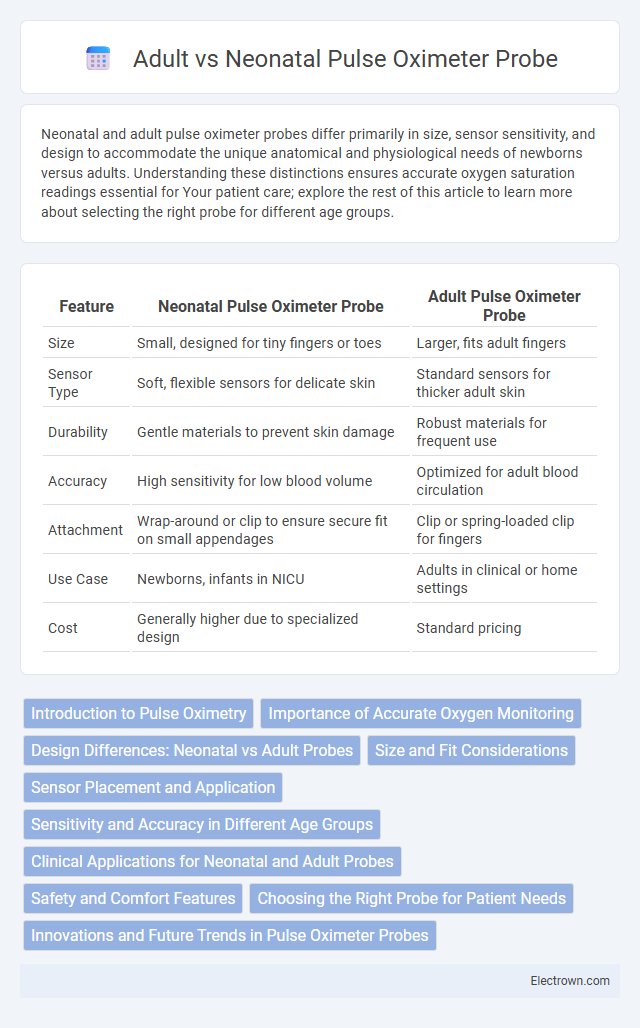Neonatal and adult pulse oximeter probes differ primarily in size, sensor sensitivity, and design to accommodate the unique anatomical and physiological needs of newborns versus adults. Understanding these distinctions ensures accurate oxygen saturation readings essential for Your patient care; explore the rest of this article to learn more about selecting the right probe for different age groups.
Table of Comparison
| Feature | Neonatal Pulse Oximeter Probe | Adult Pulse Oximeter Probe |
|---|---|---|
| Size | Small, designed for tiny fingers or toes | Larger, fits adult fingers |
| Sensor Type | Soft, flexible sensors for delicate skin | Standard sensors for thicker adult skin |
| Durability | Gentle materials to prevent skin damage | Robust materials for frequent use |
| Accuracy | High sensitivity for low blood volume | Optimized for adult blood circulation |
| Attachment | Wrap-around or clip to ensure secure fit on small appendages | Clip or spring-loaded clip for fingers |
| Use Case | Newborns, infants in NICU | Adults in clinical or home settings |
| Cost | Generally higher due to specialized design | Standard pricing |
Introduction to Pulse Oximetry
Pulse oximetry measures blood oxygen saturation and pulse rate through light absorption, crucial for monitoring respiratory and cardiac health. Neonatal pulse oximeter probes are designed with sensitive sensors and smaller sizes to accommodate fragile, tiny patient anatomy, ensuring accurate readings without causing injury. Adult probes feature larger sensors optimized for thicker skin and tissue variations, providing reliable measurements in diverse clinical settings.
Importance of Accurate Oxygen Monitoring
Accurate oxygen monitoring is crucial in both neonatal and adult pulse oximeter probes to prevent hypoxia and ensure optimal oxygen delivery tailored to each patient's physiology. Neonatal probes are specifically designed to fit smaller, more sensitive skin and provide precise readings despite low perfusion and movement, while adult probes accommodate larger digits and varied tissue thickness. Your choice of probe impacts the reliability of oxygen saturation data, directly influencing patient outcomes in critical care settings.
Design Differences: Neonatal vs Adult Probes
Neonatal pulse oximeter probes feature smaller, lightweight designs with flexible, wrap-around sensors tailored for fragile infant skin and tiny digits, ensuring accurate readings without pressure injury. Adult probes are larger, clip-style or adhesive sensors designed to fit thicker fingers or earlobes, providing durability and ease of use during extended monitoring. These design differences optimize sensor placement, comfort, and accuracy for distinctly different patient populations in clinical settings.
Size and Fit Considerations
Neonatal pulse oximeter probes are designed with smaller sensors and softer materials to accommodate the delicate and tiny fingers or toes of newborns, ensuring accurate readings and preventing skin damage. Adult probes are larger, providing a snug fit that captures pulse data effectively on bigger fingers, optimizing oxygen saturation measurement. Selecting the appropriate probe size and fit is essential for Your patient's comfort and the device's precision, tailored to their unique anatomical differences.
Sensor Placement and Application
Neonatal pulse oximeter probes are designed with smaller sensors and flexible materials to ensure accurate placement on the delicate, tiny fingers, toes, or foot of newborns without causing skin damage. Adult probes feature larger sensors suitable for fingers or earlobes, providing stable readings on thicker skin and allowing for secure attachment during movement. Correct sensor placement tailored to your patient's size optimizes measurement accuracy and comfort, crucial for effective oxygen saturation monitoring.
Sensitivity and Accuracy in Different Age Groups
Neonatal pulse oximeter probes are specifically designed with smaller sensors and enhanced sensitivity to accurately detect oxygen saturation in the delicate and low-perfusion tissues of newborns. Adult probes, by contrast, have larger sensors optimized for thicker skin and higher blood flow, ensuring accuracy in oxygen saturation readings in mature patients. The precision of neonatal probes in capturing subtle oxygen fluctuations is critical for early intervention, while adult probes maintain stability and reliability across a broader physiological range.
Clinical Applications for Neonatal and Adult Probes
Neonatal pulse oximeter probes are specifically designed for the delicate and small anatomy of newborns, providing accurate and continuous monitoring of oxygen saturation in neonatal intensive care units and during surgical procedures. Adult probes are larger, tailored for robust sensor placement on fingers or earlobes, and are used in various clinical settings such as emergency rooms, operating theaters, and general wards for continuous or spot-check monitoring. Ensuring the correct probe selection optimizes signal accuracy, patient comfort, and reliable SpO2 readings in both neonatal and adult patients.
Safety and Comfort Features
Neonatal pulse oximeter probes are specifically designed with softer, smaller sensors and flexible materials to ensure gentle attachment on fragile infant skin, minimizing the risk of pressure sores and irritation. Adult probes prioritize durability and secure fit for larger digits but include features like hypoallergenic adhesives and adjustable tension to maintain comfort during prolonged monitoring. Your choice of probe should reflect the patient's size and skin sensitivity to optimize both safety and comfort.
Choosing the Right Probe for Patient Needs
Selecting the correct pulse oximeter probe is crucial for accurate oxygen saturation readings, with neonatal probes specifically designed for the smaller, delicate fingers or toes of newborns, ensuring precise monitoring without causing discomfort or skin damage. Adult probes accommodate larger digits and generally have more robust sensor casing to withstand movement and longer usage periods. Proper probe selection optimizes sensor fit and signal detection, minimizing measurement errors and improving patient care in both neonatal and adult populations.
Innovations and Future Trends in Pulse Oximeter Probes
Innovations in pulse oximeter probes focus on improving accuracy and patient comfort for both neonatal and adult populations through the use of advanced sensor materials and wireless connectivity. Future trends include integrating AI algorithms for real-time data analysis and the development of customizable probes tailored to different patient sizes and clinical needs. Your healthcare environment can benefit from these cutting-edge technologies, offering enhanced monitoring capabilities and more reliable oxygen saturation readings.
Neonatal vs Adult Pulse Oximeter Probe Infographic

 electrown.com
electrown.com